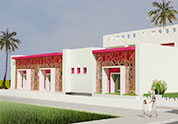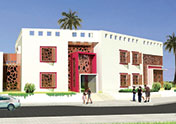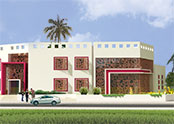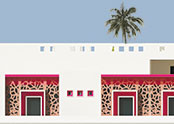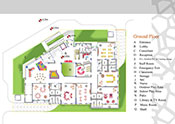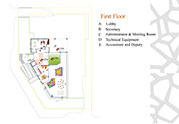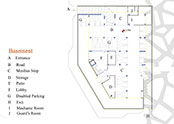Kinder Garten in Qatar
Location:
Doha-Qatar
Design Year:
2013
Construction Year:
2014
Client:
Ebla Co.
Software Programs:
AutoCAD- Max- Photoshop
For the purpose of providing those professionals a safe, healthy, educating and funny environment for their little ones to enjoy; Ark-Kassam Architectshas undertaken this design for a kindergarten which both complies with the Qatari guidelines and instructions for schools and kindergarten design and the most recent and available technologies of sustainable design.
Site & Location:
This project is situated in the heart of Doha city; the capital of the State of Qatar which is taking its leap towards being one of the most internationally recognized and active economical hub attracting many professionals form around the world in addition to local citizens who are taking their places in such development. The site is located in Al-Wakir, East Hilal area presenting an active space between several important streets and highways and commercial buildings.
Background:
For the purpose of providing those professionals a safe, healthy, educating and funny environment for their little ones to enjoy; Ark-Kassam Architectshas undertaken this design for a kindergarten which both complies with the Qatari guidelines and instructions for schools and kindergarten design and the most recent and available technologies of sustainable design. Through this design, Ark-Kassam Architects appreciation of the local culture and environment appears through providing a building that also works as an educational medium for the children during the most approachable comfort levels.
Concept:
In order to reflect the local culture along with providing a healthy and sustainable environment which touches all the three components of sustainability; namely, the environment, the economy and the social component. The concept is to use the Mashrabya screen as a reflection of a local and environmental architectural solution in covering the façades to work as a second skin after the original wall which concludes the interior space. This solution along with the proposed material for undertaking the Mashrabya design and the whole design of the class exterior section, which encompasses another element of local and environmental architecture which is the Malgaf, will reduce solar gains and provide through partially natural ventilation air circulation which will help in reducing the need for mechanic cooling loads.
Mashrabya Material and Modeling Concept:
Using ACRYLITE Product as a material for the Mashrabiya Screen in order to reduce solar gains up to 50% in total. ACRYLITE is available in different colours and can be formed and cut upon request. It comes in 135*270 plates and in different types.
The Mashrabya structure is an abstract of local palm tree log skin which reflects on the aesthetic level the local culture and environment.
Product properties
30.0% Transmission
transparent
UV absorbent
high-gloss surface
Ground Floor:
The design complies with the Qatari Guidelines for School Design in terms of areas, spaces and their occupation along with the international standards in terms of the number of students in the class. The design also takes into account the orientation of the classrooms providing the maximum lighting with less solar gains on the Eastern and Northern façades and with a full blockage of the western façade in regards to the classrooms. the plan also considered the movement of the disabled providing ramps and disabled toilets. as an interior space the patio represents a connection link between the exterior and the interior environments providing visual transparency from the entrance towards classes and vice-versa.
First Floor:
First floor is designed for the administration spaces comprising an administrator room, meeting room, secretary, deputy and accountant room linked with a wooden bridge which creates the space for mezzanine between the ground and first floor providing a visual extension and enough space for sufficient air circulation in addition to the constant visual transparency the whole design is based on which allows the parents if standing on the wooden bridge to have a full look to the interior environment of the kindergarten.
Basement:
Providing 20 parking spots two of them are designed for disabled movement in addition to two spots for mini bus parking which can be used after dropping the students upstairs in front of the kindergarten or downstairs in the parking floor where they can use safely and easily the lift to the ground floor upstairs. The basement also comprises two storage rooms.


